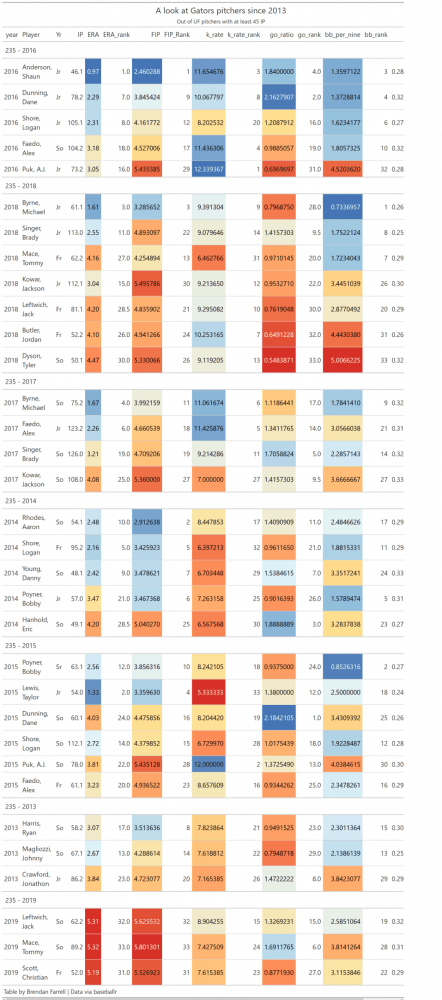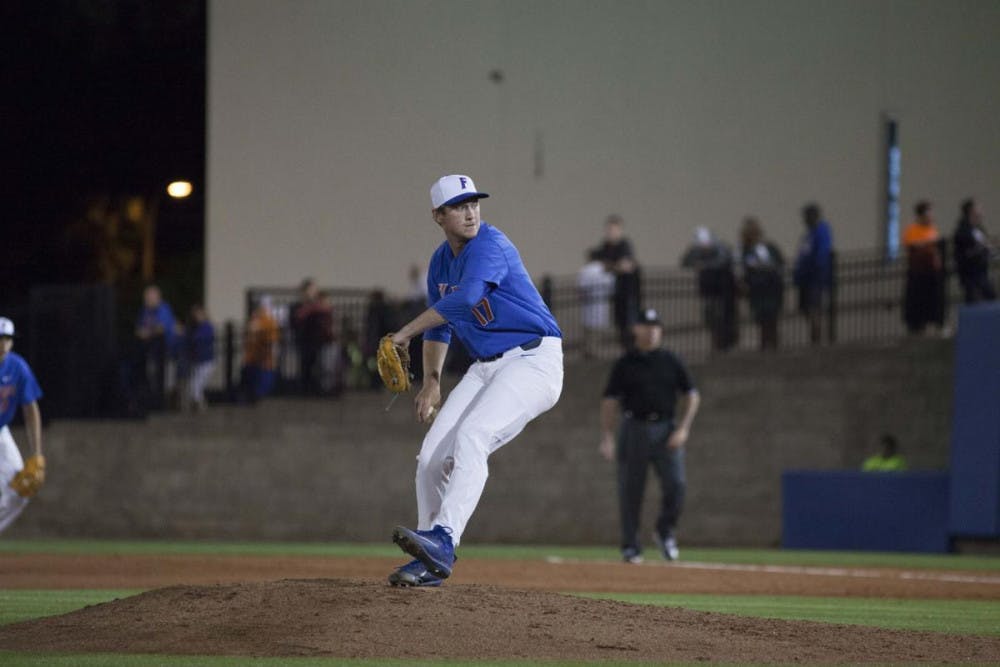Last week, I went over the bottom half of my list of the top 10 seasons by Gators pitchers. If you’re looking for familiar faces like Brady Singer and Alex Faedo or a refresher on my methodology, you can find that here.
For as much as college baseball fans and analysts talk about the impressive lineup of starting pitchers the Gators have produced over the years, many might not realize that the bullpen arms that have come through Gainesville have probably been just as good.
A team can get through the regular season leaning on a trio of starting pitchers ranging from good to elite. But, to get to Omaha and bring home the trophy, a team also needs to have reliable arms late in games. It turns out Florida has had quite a few of them.
5. Aaron Rhodes (2014)
As someone who didn’t pay that much attention to Gators baseball until I was admitted to UF, I had to look up who Aaron Rhodes was. I would say that he’s likely the closest thing to a one-hit wonder on this list.
For one, this was the only season where he made my 45-inning cutoff. But, he was also ungodly good in 2014.
Opponents rarely did anything against Rhodes, whose FIP of 2.91 was the second-best of any UF pitcher since 2013. Rhodes gave up one home run all season, the fewest of any Gators pitcher who pitched at least 10 innings in 2014.
More impressively, Rhodes had as many walks as earned runs allowed (16). At 2.48 for both per nine innings, he was solid. He didn’t strike out batters at an overwhelming rate, but the contact that opposing batters made was usually not very threatening.
Rhodes disappeared about as quickly as he emerged. His ERA jumped to 3.74, and he only pitched 31.2 innings in 2015. He was selected by the Los Angeles Angels in the 28th round of the 2015 draft and pitched 21 innings in one season in Single-A before leaving baseball entirely.
4. Michael Byrne (2017) and 3. Michael Byrne (2018)
It was only a matter of time before Michael Byrne made an appearance.
The school’s record holder in saves (35) and saves in a season (19), Byrne is arguably the most prolific reliever the team has ever had under manager Kevin O’Sullivan.
Taking over as the Gators’ closer as a sophomore in 2017 after a brief stint as a midweek starter, Byrne went from 16 innings of work in 2016 to 75.2 the following season. His ERA went from nearly 4.00 to a sterling 1.67, the seventh-best in the country.
Byrne struck out batters at a high rate (just over 11 batters per nine innings) and was ninth in walk rate. His ability to keep runners off the basepaths was crucial en route to the program’s first national title. He obliterated the school record of 13 saves with 19.
He was even better in 2018.
Byrne somehow managed to lower his ERA even further to 1.61, the third-lowest of this group. His FIP also improved from 11th to third overall (3.28).
However, his biggest strength was not giving free passes to first base. Only Bobby Poyner in 2015 was even close to Byrne’s 0.73 BB/9. To put it simply, he only walked five batters all season. His strikeout-to-walk ratio would have been the best in the country if he fulfilled the one-inning-per-game requirement.
The 2018 edition of Byrne finished in the top 10 of every category, except for his GO/AO ratio. Byrne had a very low GO/AO, meaning that more of his outs came from fly outs instead of ground outs. The Orlando native rarely gave up home runs—he only allowed eight dingers in his last two seasons—but he was by no means a groundball pitcher.
Byrne was at his best when the lights were the brightest. Between the 2017 and 2018 postseasons, he compiled 10 saves. In the 2018 postseason alone, Byrne had a 0.51 ERA in 17.2 innings.
Between all of that and a stacked list of honors that includes two-time All-American and 2018 NCBWA Stopper of the Year—the first Gator to win the award—there’s a strong argument that he’s the best reliever the Gators have ever had.
2. Dane Dunning (2016)
Something that I’ve noticed while creating this was the trend of pitchers taking tremendous leaps from their sophomore year to their junior year. The same goes for Dane Dunning.
Dunning’s sophomore campaign in 2015 actually ranks 17th on my board, but it was his 2016 performance that nearly topped the charts.
Used as a swing man, Dunning did pretty much anything and everything. At nearly 79 innings, he pitched more than anyone on Florida’s roster who wasn’t a starter, though he did make five starts. The fact that Dunning was arguably the best pitcher on a stacked arsenal that included future first-round picks Alex Faedo, Brady Singer, Jackson Kowar and A.J. Puk is telling.
Dunning ranked in the top 10 in all five categories, but his greatest attribute was being the best groundball pitcher the Gators have had since 2013. Dunning had the second-highest GO/AO ratio in 2016, and the only pitcher to have one that was higher was… 2015 Dane Dunning. Both editions of Dunning are the only seasons in this span to have at least twice as many ground outs as fly outs.
The junior nearly cut his ERA in half in 2016, going from 4.03 in 2015 to just 2.29 the following season. In the NCAA Tournament, Dunning was nearly perfect, allowing only one run in over 15 innings of work during the Gators’ trip to the College World Series.
Dunning’s performance in 2016 was enough to make him the second Florida pitcher selected in the first round of that year’s draft alongside Puk. Though he was originally selected by the Nationals with the 29th overall pick, he was later dealt to the White Sox. MLB.com ranked him as the White Sox’s No. 6 overall prospect in a farm system that it also ranked as the 11th-best in the league.
1. Shaun Anderson (2016)
Before Michael Byrne became Michael Byrne, there was Shaun Anderson.
Anderson served as the Gators’ closer for the 2016 season, and, while he didn’t stockpile saves like Byrne did, Anderson was unbelievably dominant.
The 6-foot-5 righty had an unfathomable 0.97 ERA in just over 46 innings of work for Florida, the best ERA of any UF pitcher since college baseball started using aluminum bats in 1974. Anderson was also the only pitcher since 2013 to finish top five in all five of my categories. He had the best ERA and FIP while also finishing third in K/9 and BB/9 and fourth in GO/AO.
He also managed to tie the previous school record for saves with 13 in 2016 before Byrne took a sledgehammer to the record book.
Anderson’s 2016 campaign is full of crazy stats, but the fact that he only allowed two extra-base hits all season long is unbelievable.
There’s really no other way to describe Anderson in 2016 other than just dominant. He was untouchable all season long, rarely walked anyone and barely anyone made good contact with his stuff. The NCBWA named him a First Team All-American while also making him a finalist for Stopper of the Year, which he lost to Miami’s Bryan Garcia.
Anderson was later selected by the Boston Red Sox in third round of the 2016 draft and was later traded to San Francisco. He made 28 appearances with the Giants last season, including 16 starts. He went 3-5 with a 5.44 ERA and could make the Giants’ roster for the beginning of the 2020 season.
Florida’s pitching staff in 2016 was absolutely loaded with talent, considering that it had five future first-round picks and four entries on this list. Maybe pitchers like Brady Singer and Alex Faedo were more valuable because they were starters and not relievers like Anderson and Dunning.
However, in terms of sheer dominance, nobody tops Anderson’s 2016 season.

Follow Brendan on Twitter @Bfarrell727 and contact him at bfarrell@alligator.org






